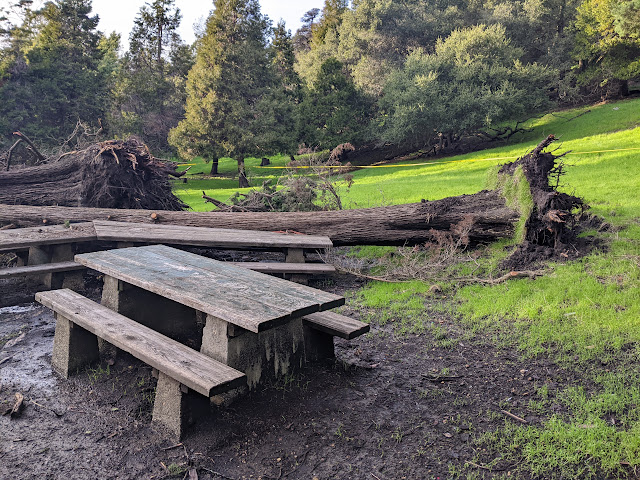Last fall and winter, I marveled at the mushrooms and wowed at the water. Life things and other urgent projects have cut down on my marveling and wowing time in recent months, but when I started walkin' in 2023, well, it was like six months of wow in a week. More like woah.

Woah.
The New Year's Eve "cyclone bomb," which they warned us about after the fact, was a feature of the coming "atmospheric river" that they'd been talking about for weeks. Many of us shrugged, preparing for storms but skeptical of the creative spin that must be put on each weather event now, to out-do all those "weather-'pocalypses" that we had a decade ago. (Are we post-apocalypse? Is this the new normal?) Weather cycles come and go, so we shall see. But until this year it was really hard to imagine things getting worse.
I moan a lot about erosion, either on this blog or to anyone who will listen. But this year it's more like an explosion. Today on my walk from the Ranger Station to the Fire Circle, I counted nearly a dozen horizontal trees that had been vertical for decades, and in some cases for over a century. In one spot behind the parking lot by a picnic area I captured three fallen trees in one shot, one of them so large it blocked the overflow lot above the dog park.

The greatest heartbreak appeared to me as I climbed up to see the former Fire Circle, which we're now hopefully calling the California Writer's Circle. It's not a circle anymore. It's a mess. I've enjoyed countless picnics and literary events here in the last two decades, always surrounded by four gentle, shade-providing giants. Three of them lay dying now, just beyond the arc of picnic tables. One lost its footing and fell on its brothers; the whole family lay still, with branches intertwined, never to wave in the wind again. And yet birds and wildlife hopped among the branches, doing their bird thing.
Last spring, when I walked Sequoia Point, no longer part of the park but rematriated to its original people, who by golly are still here,
a fallen tree was the answer to a problem. I wonder, as I walk back, how that awareness might possibly be applied right here, right now, and into the future.

The answer comes to me as I pass the road by the Elephant Barn, which a year ago had a huge redwood fall just next to but not on the old, sagging building. Although a tree that once looked right into the Ranger Station's picture window now lies across the road, what lies
along the road is the other part of the story. Clearly there were trees here: redwoods and oaks by the looks of them. Where every tree once stood, a sapling or cluster of redwood babies has sprouted.
This is the future, and it's good. The trees in this park were planted, curated, cultivated, many of them by Joaquin himself. But when trees start planting themselves, a park declares itself a forest. Forests are self-sustaining systems, and we have to strengthen them all over the earth.
But the world needs to plant a trillion trees by 2030.
Woah.
Over the past few months, writing
my dad's obituary (tl:dr - he was a
Baumgardner. Plant trees in his honor.). I've been working through feelings of loss, of being in a new world that I don't recognize or even like much anymore. I've been doing the tasks of grief. Acceptance is one. Processing feelings is another. And building a bridge from the past to a future is the third. Storms wash away the old, and nurture the new. It will be an amazing mushroom season!
To save ourselves from the changing climate, which will make storms like this stronger and less predictable, we just plain need more trees on Earth.
A trillion trees in seven years in fact. That's 125,000 trees
per person, on the Earth. That's about forty million trees a DAY that need to be put in the ground. We'll get plenty of help from nature, which plants trees automatically, but in places of deforestation, we need to do the work. You can do it yourself, locally, by working with
Friends of Sausal Creek (which was vandalized after the storm, adding insult to injury),
100KTrees4Humanity,
CommonVision, or many other urban forest & reforesting organizations. Or you can contribute to mass plantings through
Arbor Day or the web browser
Ecosia. It's a daunting but not impossible task. Ethiopia famously planted 350,000 trees in a day.
After loss, there is a moment, like today, when I realize I can see more blue sky than before, when you realize you can think outside the box. New ideas rush in so eagerly. Oakland is about to roll out its
urban forest master plan. This was a bare hill until someone decided to plant it with trees. Far below, I can see great swaths of Oakland that also deserve a canopy. At least we've got some water now to nurture new trees. Happy New Year, let's get busy.








Comments
Post a Comment